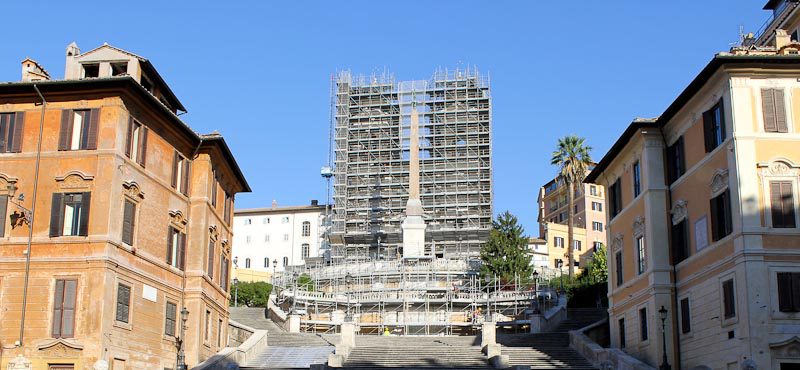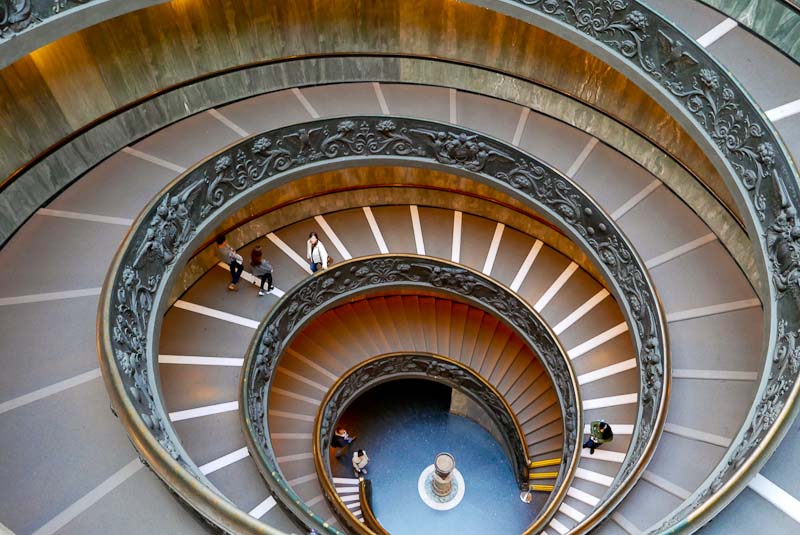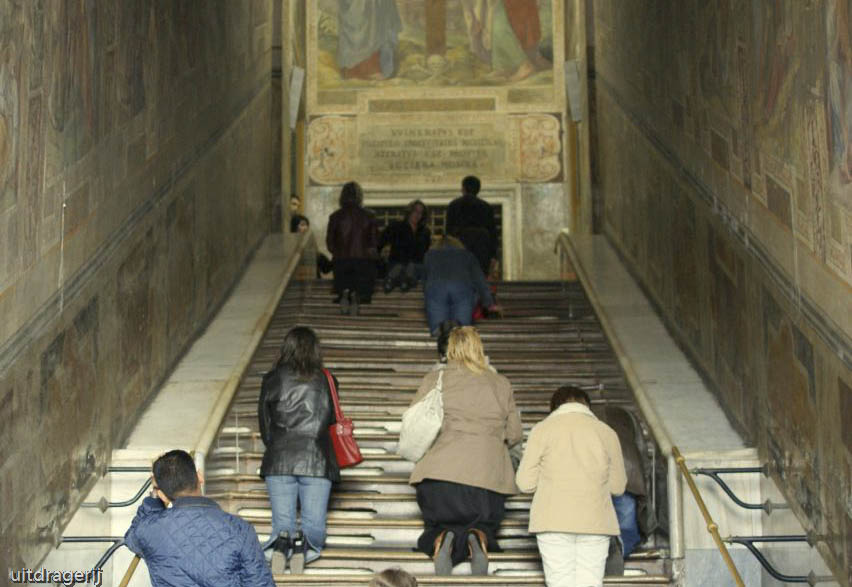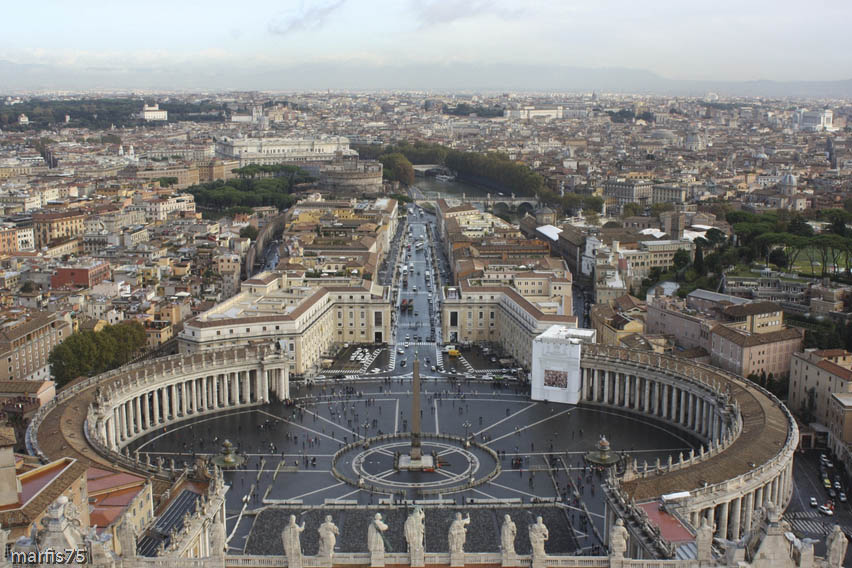5 steps to Rome
Steps to Rome: Rome is famous for its steps and staircases, and most of them are attractions in their own right and not just something you happen to stumble across on your way to other sights.
Booking.com
Here is my Top 5 of the most extraordinary steps in the city.
The Spanish Steps

The Spanish steps are currently being renovated, but part of the steps should be opened again before Christmas 2015
The Spanish Steps is the widest and one of the most momentous staircases in Europe. The construction of the 135 steps leading from Piazza di Spagna to Piazza Trinità dei Monti was build in 1723-1725 according to designs by by architects Francesco de Sanctis and Alessandro Specchi to celebrate the peace treaty between France and Spain, linking the top of the hill (under French influence, with the church of Trinità dei Monti and French monastic institutions) to the Spanish embassy at the bottom of the hill. In the Renaissance, Piazza di Spagna at the foot of the stairs was lined with hotels, inns and residences where artists and writers stayed while in Rome. In consequence, the square and the Spanish Steps became one of the most it one of most frequently painted and described attractions in city.
Helix Stairs in The Vatican Museum
One of the most beautiful staircases in Rome is the helix stairs in the Vatican Museums. The broad steps actually consist of two intertwined spirals; one leads up and another leads down to street level from the floor of the Museums. And the strange thing is that you can’t actually see the duplicity, while you are there, unless you notice the white and yellow lined steps at the bottom.
Compared to most other sights in Rome the twisted staircase is not that old, it was designed by Giuseppe Momo in 1932, but it is extremely popular – both as a sight and as a symbol of life, due to its resemblance to the double helix DNA strand (which was, however, discovered later).
Sancta Scala near Porta S. Giovanni
In Piazza San Giovanni in Laterano you’ll find the Scala Sancta, ie. the steps Jesus had to climb on his way to his trial by Pontius Pilate in Jerusalem. How the staircase ended up in Rome beats me, but the teleportation is normally attributed to Saint Helena, who had a special talent for finding Christian relics. The 28 steps in wood encased white marble have been an important pilgrim site for centuries, and if you kneel you can still see the marks left by the blood of Christ on the marble.
Stairs to the Dome of St. Peter’s Basilica
Another personal favourite are the stairs leading to the dome of Saint Peter’s, where you can see the town over the head of Bernini’s 140 statues lining the colonnade. It is an extremely crammed and narrow winding staircase leading to a magnificent and dizzying view Saint Peter’s Square and Rome. On the internet, people argue about whether there are 320 or 500 steps to the top. I didn’t keep count, but it is a hard climb, and a lot of people prefer to take the elevator part of the way.
Steps to Piazza del Campidoglio
Capitoline Hill between the Forum and Campus Martius is one of the seven hills in Rome, and the only one incorporated in an urban plan by Michelangelo.The Renaissance artist and architect designed Piazza del Campidoglio with the surrounding palaces. Ascending the hill Michelangelo devised a sloping Cordonata with steps so wide that horse riders could ascend without dismounting. The monumental balustrade is guarded by giant statues of Castor and Pollux; Twin brothers who, according to legend, fought at the head of the Roman army at the Battle of Lake Regillus and subsequently brought news of the victory back to Rome.
More that 5 steps to Rome
Trackbacks & Pingbacks
-
[…] Italian Notes – 5 steps to Rome […]
-
Italian Notes | My 7 Links says:
[…] most popular post is undoubtedly 5 steps to Rome focusing on steps and staircases in the Italian capital. Reader attention always soars for blog […]
-
A travel blog » The Radar: Rome’s Five Best Steps, Fly or Drive?, What Not to Do on a RTW Trip says:
[…] In a city entrenched in rich history, it’s hard to know which one of Rome’s many architectural marvels to see first. Check out Italian Notes blog to get an insider’s view on the city’s five best steps. [Italian Notes] […]
-
The Radar: Rome’s Five Best Steps, Fly or Drive?, What Not to Do on a RTW Trip – Intelligent Travel says:
[…] In a city entrenched in rich history, it’s hard to know which one of Rome’s many architectural marvels to see first. Check out Italian Notes blog to get an insider’s view on the city’s five best steps. [Italian Notes] […]
Leave a Reply
Want to join the discussion?Feel free to contribute!
Leave a Reply Cancel reply
This site uses Akismet to reduce spam. Learn how your comment data is processed.






This is a great list. I’ve been pining to see Rome for years, and Italy is really the only country in Europe I haven’t visited. Looking forward to it!
I’m sure you won’t be disappointed:)
Great idea for an article. I’ve been sitting on the Spanish steps a million times and often pondered why they’re called Spanish. Never remembered to check, though, so thanks for that info. Also, never climbed to the top of St Peter’s; didn’t know it was possible. Will next time. I’ll remember to count the steps :)
Thanks. Hope you’ll let me know where the count ends, because I inevitably lose the thread, before I reach the top.
Wow! You’d never need a gym membership in Rome–just climb some steps! I want to try the Helix Stairs.
What a great idea for a post :)
What an interesting article! I haven’t been to Rome and didn’t know about these staircases. Hope to climb them all myself sometime.
There’s something so romantic about a gorgeous staircase!
What an interesting idea for an article. I think the Helix Stairs were my favorite.
Hi Laurel, They’re mine too – I find the eternal circle has an instant appeal.
Great list. I love Rome – was just there just a couple of month’s ago. I really loved the Scala Sancta – managed to get off a great shot from the top of the stairs.
Hi Don, I find it hard to photograph those places, so I’d love to see your shot.
The Spanish Steps will always be my favourite steps in Roma.
Judging from the crowds, a lot of people seem to share that view:)
I heart Rome! I have only been once for 3 days, so I didn’t really know about all of the staircases. A creative post.
Thanks Stephanie, It’s always nice to have something to look forward to.
The Spanish Steps is the widest and one of the most momentous staircases in Europe. The construction of the 135 steps leading from Piazza di Spagna to Piazza Trinità dei Monti was build in 1723-1725 according to designs by by architects Francesco de Sanctis and Alessandro Specchi to celebrate the peace treaty between France and Spain, linking the top of the hill (under French influence, with the church of Trinità dei Monti and French monastic institutions) to the Spanish embassy at the bottom of the hill. In the Renaissance, Piazza di Spagna at the foot of the stairs was lined with hotels, inns and residences where artists and writers stayed while in Rome. In consequence, the square and the Spanish Steps became one of the most it one of most frequently painted and described attractions in city.
Great idea for a blog post. I’ve been to all those places but that spiral staircase at the Vatican museum is the most elegant.
You’re right. The spiral is my favourite, too, but they all lead to different experiences:)
What a unique idea for an article. Very creative. The next time I’m in Rome, I’ll be looking at steps with a new perspective.
THIS is a great post, especially now I can read with eyes of someone who will be going to Rome soon. The Spanish Steps and the helix stairs look spectacular. :)
Julia
I love the pictures of the stairs! I am very much looking forward to seeing them myself next month.
Rome has so much history in the streets (and stairs)! Growing up reading Asterix, I have always been fascinated with Rome, but never found time to go there!
Asterix is one of the the most captivating introductions to ancient Rome I know. Pity you haven’t found time to go there yet.